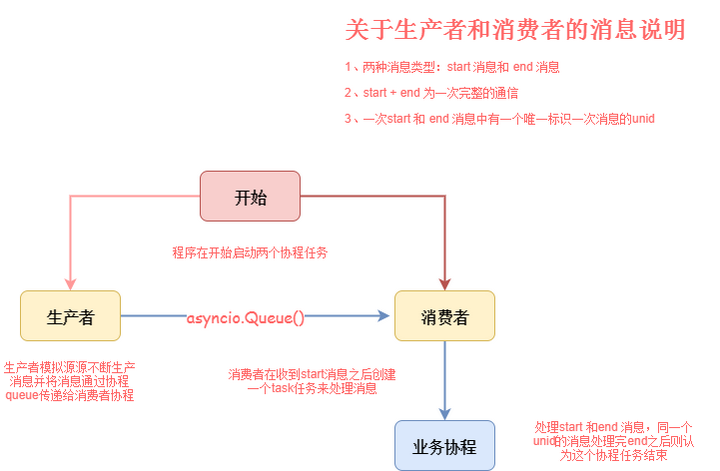一、使用 asyncio 總結 最近在公司的一些項目中開始慢慢使用python 的asyncio, 使用的過程中也是各種踩坑,遇到的問題也不少,其中有一次是記憶體的問題,自己也整理了遇到的問題以及解決方法詳細內容看:https://www.syncd.cn/article/memory_trouble ...
一、使用 asyncio 總結
最近在公司的一些項目中開始慢慢使用python 的asyncio, 使用的過程中也是各種踩坑,遇到的問題也不少,其中有一次是記憶體的問題,自己也整理了遇到的問題以及解決方法詳細內容看:https://www.syncd.cn/article/memory_trouble
在前面整理的三篇asyncio文章中,也都是使用asyncio的一些方法,但是在實際項目中使用還是避免不了碰到問題, 在這周的工作中遇到之前碰見過的問題,一個初學asyncio寫代碼中經常會碰到的問題,我的業務代碼在運行一段時間後提示如下錯誤提示:
Task was destroyed but it is pending!task: <Task pending coro=<HandleMsg.get_msg() done, defined at ex10.py:17> wait_for=<Future cancelled>>
這個錯誤我在前面幾篇關於asyncio的系列文章中也反覆說過這個問題,我也認為自己不會在出現這種問題,但是意外的是,我的程式還是出現了這個錯誤。
我將我的業務代碼通過一個demo代碼進行模擬復現以及解決這個問題,下麵整理的就是這個過程
二、“Task was destroyed but it is pending!”
我通過下麵這張圖先描述一下demo程式的邏輯:

import asyncio from asyncio import Queue import uuid from asyncio import Lock from asyncio import CancelledError queue = Queue() class HandleMsg(object): def __init__(self, unid, coroutine_queue, handle_manager): self.unid = unid self.coroutine_queue = coroutine_queue self.handle_manager = handle_manager async def get_msg(self): while True: coroutine_msg = await self.coroutine_queue.get() msg_type = coroutine_msg.get("msg") if msg_type == "start": print("recv unid [%s] is start" % self.unid) else: print("recv unid [%s] is end" % self.unid) # 每個當一個unid收到end消息為結束 await self.handle_manager.del_unid(self.unid) class HandleManager(object): """ 用於unid和queue的關係的處理 """ def __init__(self): self.loop = asyncio.get_event_loop() self.lock = Lock(loop=self.loop) self.handle_dict = dict() async def unid_bind(self, unid, coroutine_queue): async with self.lock: self.handle_dict[unid] = coroutine_queue async def get_queue(self, unid): async with self.lock: if unid in self.handle_dict: return self.handle_dict[unid] async def del_unid(self, unid): async with self.lock: if unid in self.handle_dict: self.handle_dict.pop(unid) def make_uniqueid(): """ 生成unid """ uniqueid = str(uuid.uuid1()) uniqueid = uniqueid.split("-") uniqueid.reverse() uniqueid = "".join(uniqueid) return uniqueid async def product_msg(): """ 生產者 """ while True: unid = make_uniqueid() msg_start = {"unid": unid, "msg": "start"} await queue.put(msg_start) msg_end = {"unid": unid, "msg": "end"} await queue.put(msg_end) loop = asyncio.get_event_loop() await asyncio.sleep(0.2, loop=loop) async def consumer_from_queue(handle_manager): """ 消費者 """ while True: msg = await queue.get() print("consumer recv %s" % msg) msg_type = msg.get("msg") unid = msg.get("unid") if msg_type == "start": coroutine_queue = Queue() # 用於和handle_msg協程進行數據傳遞 handle_msg = HandleMsg(unid, coroutine_queue, handle_manager) await handle_manager.unid_bind(unid, coroutine_queue) await coroutine_queue.put(msg) loop = asyncio.get_event_loop() # 每次的start消息創建一個task 去處理消息 loop.create_task(handle_msg.get_msg()) else: coroutine_queue = await handle_manager.get_queue(unid) await coroutine_queue.put(msg) if __name__ == "__main__": loop = asyncio.get_event_loop() handle_manager = HandleManager() # 在最開始創建了兩個task 分別是生產者和消費者 loop.create_task(product_msg()) loop.create_task(consumer_from_queue(handle_manager)) loop.run_forever()
上面的代碼錶面上看沒啥問題,我們先看看運行效果:
consumer recv {'unid': '784f436cfaf388f611e94ca974e1ffbe', 'msg': 'start'}
consumer recv {'unid': '784f436cfaf388f611e94ca974e1ffbe', 'msg': 'end'}
Task was destroyed but it is pending!
task: <Task pending coro=<HandleMsg.get_msg() done, defined at demo.py:17> wait_for=<Future cancelled>>
Task was destroyed but it is pending!
task: <Task pending coro=<HandleMsg.get_msg() done, defined at demo.py:17> wait_for=<Future cancelled>>
Task was destroyed but it is pending!
task: <Task pending coro=<HandleMsg.get_msg() done, defined at demo.py:17> wait_for=<Future cancelled>>
Task was destroyed but it is pending!
task: <Task pending coro=<HandleMsg.get_msg() done, defined at demo.py:17> wait_for=<Future cancelled>>
Task was destroyed but it is pending!
task: <Task pending coro=<HandleMsg.get_msg() done, defined at demo.py:17> wait_for=<Future cancelled>>
Task was destroyed but it is pending!
task: <Task pending coro=<HandleMsg.get_msg() done, defined at demo.py:17> wait_for=<Future cancelled>>
..........
程式沒運行一段時間都會出現上面顯示的錯誤提示,我先看看錯誤提示的信息:
Task was destroyed but it is pending!task: <Task pending coro=<HandleMsg.get_msg() done, defined at demo.py:17> wait_for=<Future cancelled>>
上面提示的其實就是我的task 是在pendding狀態的時候被destroyed了,代碼行數以及調用方法都告訴我們了是在:HandleMsg.get_msg() done, defined at demo.py:17
其實問題也比較好找,我們為每個unid創建了一個task來處理消息,但是當我們收到每個unid消息的end消息之後其實這個task任務對於我們來說就已經完成了,同時我們刪除了我的unid和queue的綁定,但是我們並沒有手動去取消這個task。
註意:這裡我其實也有一個不理解的地方:關於這個task為什麼會會destroyed,這個協程里是一個死迴圈一直在收消息,當queue裡面沒有消息協程也應該一直在await 地方在等待才對,但是如果我們把收到end消息的那個地方的刪除unid和queue的綁定關係不刪除,那麼這個任務是不會被descroyed。所以沒有完全明白這裡的機制,如果明白的同學歡迎留言討論
但是即使上面的機制我們有點不是特別明白,我們其實也應該把這個task手動進行cancel的,我們們將上面的代碼稍微進行改動如下:
async def get_msg(self): try: while True: coroutine_msg = await self.coroutine_queue.get() msg_type = coroutine_msg.get("msg") if msg_type == "start": print("recv unid [%s] is start" % self.unid) else: print("recv unid [%s] is end" % self.unid) # 每個當一個unid收到end消息為結束 await self.handle_manager.del_unid(self.unid) current_task = asyncio.Task.current_task() current_task.cancel() # 手動cancel 當前的當前的task except CancelledError as e: print("unid [%s] cancelled success" %self.unid)
這裡有個問題需要註意就是當我們對task進行cancel的時候會拋出cancelledError異常,我們需要對異常進行處理。官網也對此進行專門說明:
https://docs.python.org/3.6/library/asyncio-task.html#coroutine
內容如下:
cancel() Request that this task cancel itself. This arranges for a CancelledError to be thrown into the wrapped coroutine on the next cycle through the event loop. The coroutine then has a chance to clean up or even deny the request using try/except/finally. Unlike Future.cancel(), this does not guarantee that the task will be cancelled: the exception might be caught and acted upon, delaying cancellation of the task or preventing cancellation completely. The task may also return a value or raise a different exception. Immediately after this method is called, cancelled() will not return True (unless the task was already cancelled). A task will be marked as cancelled when the wrapped coroutine terminates with a CancelledError exception (even if cancel() was not called).
三、小結
雖然還有一些地方不太明白,但是隨著用的越多,碰到的問題越多,一個一個解決,可能現在對某些知識還有點模糊,但是至少比剛開始使用asyncio的時候清晰了好多,之前整理的三篇文章的連接如下:
https://www.syncd.cn/article/asyncio_article_01
https://www.syncd.cn/article/asyncio_article_02
https://www.syncd.cn/article/asyncio_article_03
也歡迎加入交流群一起討論相關內容:948510543



